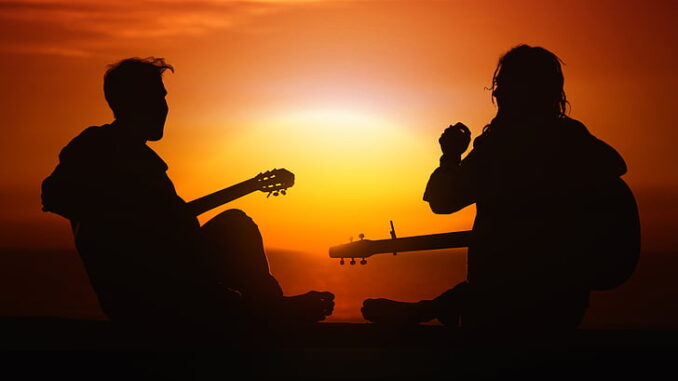

If Americana is an umbrella term for all roots-based American music – bluegrass, blues, country, folk, jazz, rock, and soul (which is how I define it, anyway) – then you’d be hard-pressed to find another group more worthy of the Americana label than New Grass Revival.
During the 1970s and ‘80s, the New Grass Revival expanded more than anyone else the parameters and expectations of what traditional bluegrass instrumentation could do. They were among a group of younger musicians that were influenced by the revolution that was happening in every corner of the music world. They grew their hair long and wore “street” clothes instead of the traditional matching suits Bill Monroe and the Stanley Brothers donned. Also, with the success of Gram Parsons and the Flying Burrito Brothers, the Grateful Dead’s ‘American Beauty’ and ‘Workingman’s Dead’ (plus their offshoot, the New Riders of the Purple Sage’s debut), and the Nitty Gritty Dirt Band’s ‘Will the Circle Be Unbroken’ in 1971, the New Grass Revival found themselves in the right place at the right time.
Formed in 1972 by former members of the influential collective, The Bluegrass Alliance, the New Grass Revival originally included Sam Bush on vocals, fiddle, guitar, and mandolin; Courtney Johnson on banjo and vocals; bassist Ebo Walker; and Curtis Burch on guitar, dobro, and vocals. That lineup only lasted through their eponymously-titled debut however, before Walker left and was replaced briefly by Butch Robins before handing the bass chair permanently over to John Cowan in 1974. Blessed with powerful vocal chops that not only could deliver the high lonesome harmony that bluegrass so often required, Cowan could also go toe-to-toe with most hard rock singers of the day. He would stretch notes to their breaking point, scream, and howl. Both his tone and phrasing were closer to gospel, soul, and blues than to anything resembling the stereotypical nasal delivery that up until then dominated bluegrass.
Throughout the ‘70s their instrumental prowess on stage and in the studio mixed with the incredible vocal power of Cowan expanded their fanbase to progressive circles even as the more traditional bluegrass community scoffed. They were even picked by Leon Russell to be his backup band and open his shows at the dawn of the ‘80s, resulting in a live album in 1981.
Tired of touring, Burch and Johnson exited in 1981, making way for guitarist/vocalist Pat Flynn and banjo virtuoso Bela Fleck to join, resulting in their most successful lineup. Together, their playing became even more adventurous even as it grew to be more commercially fruitful. They signed to Durham, NC’s Sugar Hill Records and released ‘On The Boulevard’ in 1984, which included their usual melding of folk, gospel, rock, country, and bluegrass, as well as a beautiful cover of Bob Marley’s ‘One Love / People Get Ready.’ Following with ‘Live,’ they reached new heights as they expanded Bush’s ‘Sapporo’ to 18-plus minutes.
In 1986, they signed with EMI and charted with their second self-titled album. It included Fleck’s Grammy-nominated instrumental, ‘Seven by Seven.’ Though they were creeping closer to contemporary country on their non-instrumental work, they never sacrificed their progressive roots, proven on 1987’s Capitol release, ‘Hold on to a Dream’ which included their most adventurous instrumental to date, ‘Metric Lips.’
Their final album would prove their most successful. 1989’s ‘Friday Night in America’ featured their first and only top 40 hit, ‘Calling Baton Rouge,’ so it was a shock when they disbanded that same year. Before doing so however, they came full circle, so to speak, and appeared on the Nitty Gritty Dirt Band’s ‘Will the Circle Be Unbroken, Volume 2.’
In the years since, Garth Brooks would record and have hits with both ‘Callin’ Baton Rouge’ and Pat Flynn’s ‘Do Whatcha Gotta Do.’ Bela Fleck formed the Grammy-winning prog-jazz group the Flecktones, while John Cowan released a soul covers album, ‘Soul’d Out,’ as well as a handful of Americana-leaning projects, and Sam Bush has also recorded several adventurous and critically-acclaimed albums.
Although a generation has passed since they’ve been together, the ground-breaking music the New Grass Revival created, and the doors they opened for adventurous acoustic music, still reverberate throughout the world of Americana.
The career: Nine studio albums, two live albums, three compilations, and collaborations with Peter Rowan and Leon Russell.
Key release: ‘Callin’ Baton Rouge’ is their only top 40 hit (hitting number 37 on the U.S. charts in 1989) and was later a top 5 hit for Garth Brooks. Despite their many years as purveyors of progressive acoustic music, this may be the track for which they are most identified.


